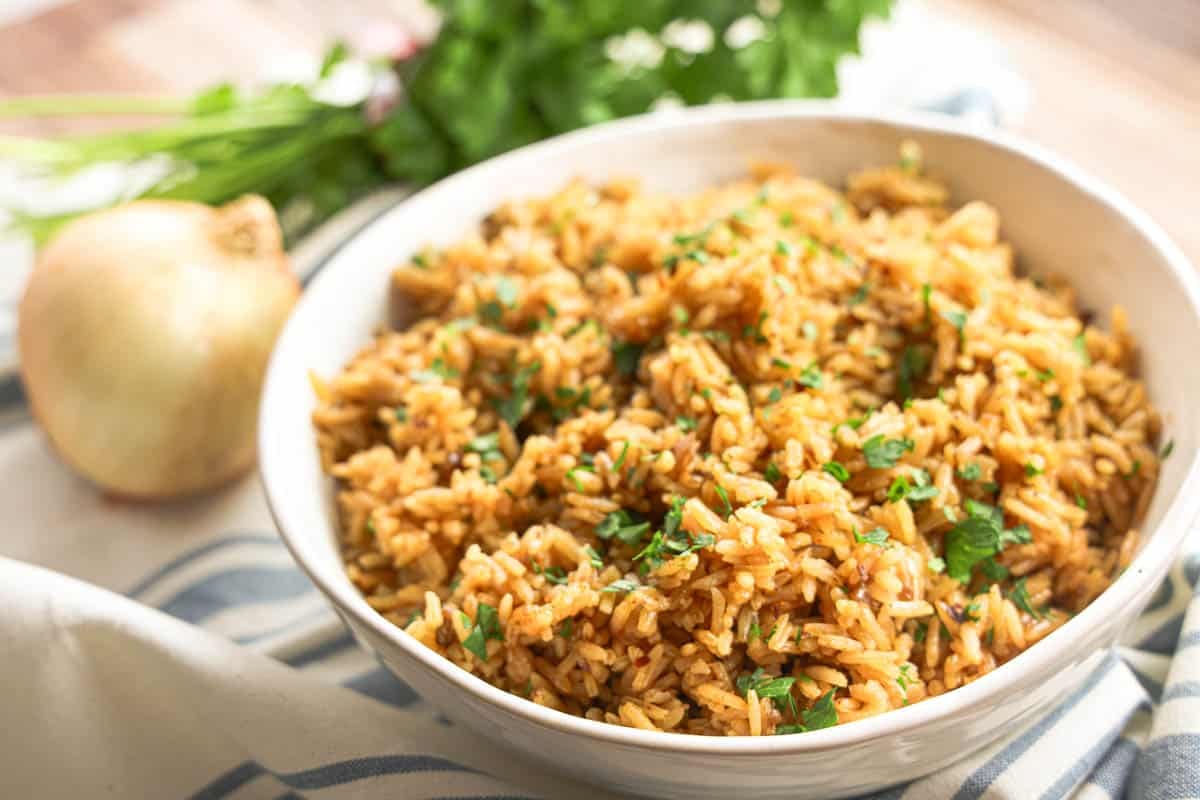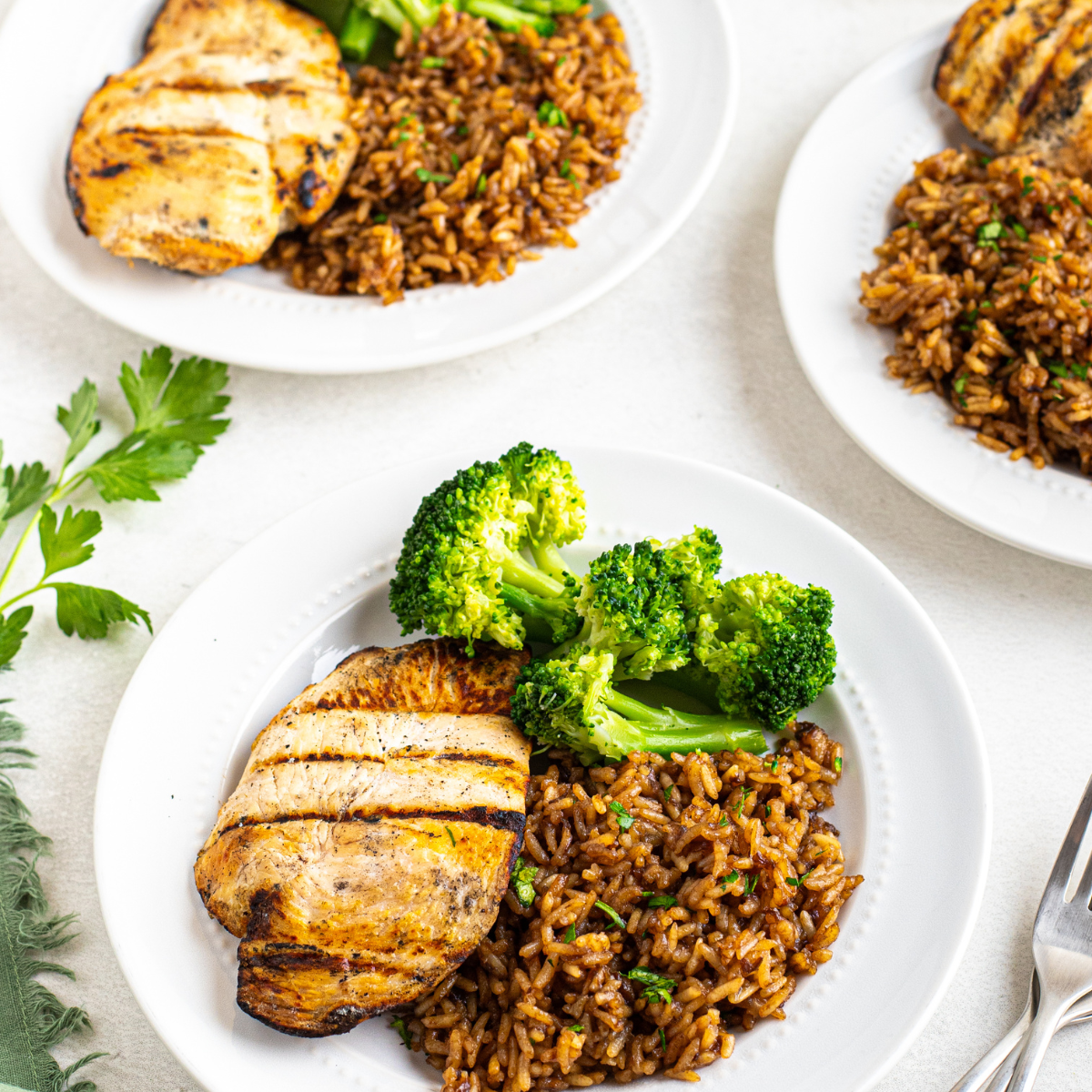Are you looking for a simple way to make Texas Roadhouse seasoned rice at home? I’m offering an easy recipe that transforms plain rice into a flavorful, seasoned side dish perfect for any meal.

Imagine the rich aroma of buttered, spiced rice filling your kitchen. It’s a side dish that instantly makes any meal feel like a special occasion. I’ve tested many recipes, but this one captures the authentic taste of Texas Roadhouse perfectly.
This easy-to-make seasoned rice comes together in just minutes, using simple ingredients you likely already have. It’s full of flavor, with bold spices that make every bite exciting. Once you try it, you’ll see how simple ingredients can create a restaurant-quality side right at home.
With just a few steps, you’ll turn plain rice into a delicious, smoky, and savory dish. Whether serving steak, chicken, or seafood, this rice will impress everyone at the table. Get ready to enjoy a side that adds extra flair and flavor to any meal.
1. Texas Roadhouse Seasoned Rice Recipe

Whip up this Texas Roadhouse Seasoned Rice in minutes—simply sauté long grain white rice in melted butter until golden, then stir in onions, paprika, garlic powder, and red pepper flakes for a burst of bold flavor. Finished with chicken stock, this fluffy, savory side dish is perfect to serve alongside steak, chicken, or seafood, making every meal feel like a restaurant feast at home!
Read the Recipe: Texas Roadhouse Seasoned Rice Recipe
2. Texas Roadhouse Seasoned Rice

Texas Roadhouse Seasoned Rice is a flavorful rice pilaf cooked with butter, seasonings, and chicken stock, giving it a rich and slightly spicy kick from crushed red pepper flakes. Just rinse the rice until the water runs clear, sauté it until golden, then simmer with seasonings and stock for about 25-30 minutes to get perfectly fluffy, delicious rice every time.
Read the Recipe: Texas Roadhouse Seasoned Rice
3. Texas Roadhouse Seasoned Rice [insanelygoodrecipes.com]
![Texas Roadhouse Seasoned Rice [insanelygoodrecipes.com]](https://insanelygoodrecipes.com/wp-content/uploads/2021/04/Texas-Roadhouse-Seasoned-Rice-7.jpg)
This Texas Roadhouse Seasoned Rice is a buttery, bold, and savory dish made with toasted rice, garlic, onion, and spices, all cooked in flavorful chicken stock. Ready in under 30 minutes, it’s perfect as a side for steak, chicken, or seafood, and tastes just like the restaurant’s beloved version!
Read the Recipe: Texas Roadhouse Seasoned Rice [insanelygoodrecipes.com]
4. Texas Roadhouse Seasoned Rice (copycat)

Transform plain white rice into bursting with bold flavors by sautéing it with butter and onions, then cooking it in savory chicken broth blended with soy sauce and a special mix of garlic powder, paprika, cayenne pepper, and black pepper. In just 30 minutes, you’ll have a delicious, restaurant-style seasoned rice that’s perfect as a side for steaks, pork, or any favorite main dish!
Read the Recipe: Texas Roadhouse Seasoned Rice (copycat)
5. Copycat Texas Roadhouse Seasoned Rice

This Copycat Texas Roadhouse Seasoned Rice is a savory and smoky side that’s perfect with any main dish. Simply sauté onions, toss in spices, broth, and rice, then let it all cook together so the flavors soak in beautifully, creating a deliciously comforting dish packed with flavor.
Read the Recipe: Copycat Texas Roadhouse Seasoned Rice
6. Texas Roadhouse Seasoned Rice Recipe with Ingredients ❤️

This Texas Roadhouse Seasoned Rice is a flavorful and easy-to-make side that’s packed with aromatic herbs and spices, delivering a savory and slightly tangy taste. Each fluffy grain is perfectly tender with a delightful texture, making it a versatile dish that pairs beautifully with grilled meats or stands out on its own.
Read the Recipe: Texas Roadhouse Seasoned Rice Recipe with Ingredients ❤️
7. Cheryl’s Texas Roadhouse Rice (copy cat)

Melt butter in a cast iron pan, then sauté rice until it starts to brown. Add chopped onions, and once everything is golden, transfer it to the instant pot with soy sauce, chicken broth, bouillon, and a mix of seasonings, then cook for about 20 minutes until flavorful and perfectly tender.
Read the Recipe: Cheryl’s Texas Roadhouse Rice (copy cat)
8. Texas Roadhouse Seasoned Rice Recipe (Easy Copycat)

Experience the flavor magic of Texas Roadhouse Seasoned Rice by baking long-grain rice in savory beef stock with Creole spices until fluffy and flavorful. Simply mix five ingredients, pop it into the oven, and enjoy a deliciously aromatic side dish that’s easy to make and guaranteed to impress!
Read the Recipe: Texas Roadhouse Seasoned Rice Recipe (Easy Copycat)
9. Texas Roadhouse Rice

This Texas Roadhouse Seasoned Rice is packed with beefy flavor and a subtle spicy kick, making it an exciting side dish that perfectly complements steaks or stir-fries. Made by browning rice in butter, adding flavorful seasonings, and cooking it in rich beef stock combined with French onion soup, this easy-to-make recipe results in a savory, zesty rice that pairs wonderfully with any hearty meal.
Read the Recipe: Texas Roadhouse Rice
10. Texas Roadhouse Seasoned Rice [imhungryforthat.com]
![Texas Roadhouse Seasoned Rice [imhungryforthat.com]](https://imhungryforthat.com/wp-content/uploads/2023/04/Easy-Texas-Roadhouse-rice.jpg)
Get ready for a flavor-packed adventure with this Texas Roadhouse seasoned rice! Just toast some fluffy long-grain rice in butter, then simmer it with tasty chicken broth and a vibrant blend of spices—paprika, garlic, and red pepper—that make every bite irresistible.
Read the Recipe: Texas Roadhouse Seasoned Rice [imhungryforthat.com]
11. How To Make Texas Roadhouse Seasoned Rice (With Step By Step Photos)

Create Texas Roadhouse Seasoned Rice easily at home by cooking rinsed long-grain rice in a flavorful mix of butter, chicken broth, and spiced seasonings like paprika, garlic powder, and dried parsley. This tender, fluffy rice is the perfect side dish to elevate any meal with its savory and mildly smoky flavor!
Read the Recipe: How To Make Texas Roadhouse Seasoned Rice (With Step By Step Photos)
12. Texas Roadhouse Seasoned Rice [nodashofgluten.com]
![Texas Roadhouse Seasoned Rice [nodashofgluten.com]](https://nodashofgluten.com/wp-content/uploads/2025/04/Texas-Roadhouse-Seasoned-Rice-1.png)
Imagine sinking into a plate of golden, fragrant rice that’s buttery, smoky, and packed with warm spices—that’s what you’ll get with this Texas Roadhouse Seasoned Rice! It’s super easy to make in just one pot, using simple pantry staples like rice, butter, chicken broth, soy sauce, onions, and spices to create a bold, flavorful side that pairs perfectly with grilled meats or a fried egg.
Read the Recipe: Texas Roadhouse Seasoned Rice [nodashofgluten.com]
13. Texas Roadhouse Seasoned Rice Recipe (Copycat)

Experience the burst of flavor with Texas Roadhouse Seasoned Rice, a simple yet delicious side dish that comes together in just 25-30 minutes. With fragrant onions, green bell peppers, garlic, and a hint of paprika, this recipe transforms basic rice into a mouthwatering treat to elevate any meal!
Read the Recipe: Texas Roadhouse Seasoned Rice Recipe (Copycat)
14. Seasoned Rice

This Seasoned Rice is your new favorite side dish, packed with flavorful seasonings like paprika, garlic powder, and a hint of cayenne that transform simple rice into something special. Just toast the rice with shallots in butter and oil, then simmer it in a tasty mix of chicken broth and soy sauce until tender—perfect for any meal!
Read the Recipe: Seasoned Rice
15. Texas Roadhouse Seasoned Rice [www.foodlovinfamily.com]
![Texas Roadhouse Seasoned Rice [www.foodlovinfamily.com]](https://www.foodlovinfamily.com/wp-content/uploads/2021/06/Texas-Roadhouse-Rice.jpg)
This Copycat Texas Roadhouse Seasoned Rice is bursting with flavor and comes together in just about 30 minutes, making it a perfect side dish for any meal. The rice is toasted in butter, then simmered with broth, spices, and herbs to create a deliciously savory, slightly smoky, and colorful dish that everyone will love.
Read the Recipe: Texas Roadhouse Seasoned Rice [www.foodlovinfamily.com]
16. Texas Roadhouse seasoned rice

Imagine the delicious aroma of buttery, spice-packed seasoned rice straight from Texas Roadhouse filling your kitchen. In just 30 minutes, you can whip up this flavorful dish with tender rice simmered in savory chicken broth, infused with paprika, garlic, red pepper flakes, and fresh parsley, making every bite a bold, mouthwatering experience.
Read the Recipe: Texas Roadhouse seasoned rice
